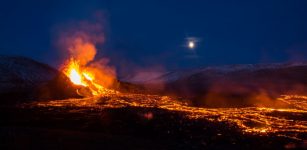Can Virtual Reality Save The Planet?
Eddie Gonzales Jr. – MessageToEagle.com – On Aug. 9, the U.N. released a dire climate report, the first since 2018, that warned of accelerated warming of the planet and splashed code red alert headlines across the world. To bring the Earth back from the brink will demand powerful collective action, the authors of the report wrote. But while the urgency of the message is growing in the public sphere, scientists, journalists, artists and creators have still so far struggled to communicate it effectively to large numbers of global citizens.
A clip of an NYC alley at night from the virtual reality world “2100.” Credit: StudioTEKA
Some of them are now pinning their hopes on virtual reality (VR) to get the message across. In fact, a substantial body of research from the Stanford Virtual Human Interaction Lab has shown that using virtual reality to change human behavior works. But how does it work, and what kinds of VR experiences can most effectively reach the largest numbers of people and have the most impact? Where can these VR experiences be delivered to people? Is VR just a communication tool or can it be something more?
To answer these questions we spoke with Vanessa Keith, an adjunct associate professor at Columbia Graduate School of Architecture Planning and Preservation, a registered architect, and the principal of StudioTEKA an award-winning design firm based in Brooklyn that she founded in 2003. Keith is especially interested in design-oriented solutions to climate change and is currently building a massively multiplayer online role-playing game (MMORPG) and open virtual world that develops concepts from her book “2100 A Dystopian Utopia: The City After Climate Change.”
Published in 2017 by the late Michael Sorkin’s Terreform, the publishing arm of a nonprofit architecture and urban think-tank focused on ecological design, Keith’s book re-imagines 14 cities around the world employing emerging tech to tackle the climate crisis. Keith is hoping to do a beta release of the game within a year that includes virtual renderings of New York City and Moscow.
A trailer for it, narrated by a guide named Violet, shows a city enveloped in fog, gloom and neon, populated by flying taxis, glittering high rises, and dreamy gardens and parks. It recalls the iconic futuristic noir of Blade Runner, only with far more plant life. The interview has been edited for length and clarity.
Kristen French: What drew you to work in Virtual Reality?
Vanessa Keith: Well, I’ve always been interested in new technologies and modes of representation. But in 2016, we teamed up with the Glimpse Group, a virtual and augmented reality platform company, and they put part of our New York case study from the book into VR. It was really fun. They had us walk a simulated gangplank 200 feet above the city and then asked everyone to jump down, and a lot of people couldn’t do it, even though they were really just in an office. I did it and it was incredible, how real it felt.
I have been called an eco-futurist, but really, my whole aim is: how can I reach people? VR is a powerful tool for that. For instance, Stanford University’s Virtual Human Interaction Lab found that if a person has a VR experience of cutting down a tree—feels the chainsaw vibrate, hears the tree crash—that person is much more likely to conserve paper.
That’s really interesting. The immersive nature of the medium impacts all of your senses and overwhelms the physical space around you. It’s almost a cliché now, but it has been called an empathy machine and for me that’s really what links it with climate.
KF: How are you using virtual reality in your work right now?
VK: We’re aiming to develop the concepts in my book, “2100,” into a massively multiplayer online role-playing game, an open virtual world where people operate avatars tasked with creating new ways to protect our cities against climate change threats. Players in this multiverse complete quests for points and expertise. They can choose between various roles: explorer, creator, destroyer, poacher.
Explorers, for instance, chase storms and help cities prepare for them. Creators design solutions to slow climate change, such as CO2 capture, and can even interface with real inventors in the virtual world or learn technical skills, such as how do I fix or maintain a solar array?
Destroyers recycle defunct or non-sustainable elements of the city. We even have room for poachers, who steal things and undermine climate solutions, because there are going to be people who want to be nefarious. But if they are caught in the act, they relinquish all of their points.
KF: What kind of impact do you hope your VR multiplayer game will have?
VK: One of the things that I’ve found consistently in my research is that we don’t lack solutions to climate change, we lack political will. At the same time, I think that people who are inventing things and people who are thinking of solutions are still in silos, in different fields in different countries, so I’m really hoping that this can be a place where people can connect and share ideas. Also, a lot of the messaging around climate change is intensely negative. Maybe it’s not reaching people because it’s just so daunting. Maybe we could get more people on board using fun, because fear doesn’t seem to be working. People just shut down.
Now what if a by-product of your enjoyment of this online multiplayer game is actually doing good works in the world outside of the game? I think that we can be doing things with proof-of-stake nonfungible tokens (NFTs), which require far less energy to sustain than traditional NFTs.
Like we could be generating money that would be used to fund work that would combat climate change in the real world, such as planting trees, sequestering carbon and supporting the efforts of NGOs that are working to battle the climate crisis. Some of the environments in the world are like works of digital art, right? So it could be that there are moments in the world that someone could buy and amass points. A lot of these games, especially MMORPGs, start to have their own ecosystems.
It’s also important for us that we have a green server powering this and that we are not greenwashing, right? We really hope to realize our vision for a new kind of ethically and socially conscious multiplayer game. We hope it will expand the Metaverse, vastly broadening its audience, bridge virtual and real worlds, and make a real difference to the future of our planet. Our vision for “2100” is one of ongoing expansion, community building and a trove of real-world applications. “2100” will become a community-gathering place for eco-aware people, while also turning gameplay from a mere pastime into a transformative adventure.
KF: It seems like the immersive nature of the virtual world makes it a really useful tool not just for communicating the impacts of climate change but for imagining the future of cities?
VK: Yes, because you are in a one-to-one relationship with space. It’s an incredible tool. I have taught design for 15 years at Columbia and the University of Pennsylvania and one of the hardest things for beginning students of architecture to understand is that this thing that you’re designing is not a toy. Half of the struggle is actually being able to picture yourself as a small, tiny human within that space.
With a headset, you can immediately see what it looks like at scale. It could help a lot with what I see as a crisis of imagination, the inability to envision the world as anything different than it is right now.
KF: Are there any VR climate change projects that really inspire you?
VK: Marshmallow Laser Feast is fantastic. They did two pieces. One is “In the Eyes of the Animal.” The other one is “Ocean of Air.” Winslow Porter and Milica Zec at Stanford did “Tree,” which I mentioned already. I’ve been working with Tamiko Thiel, a VR artist based in Munich. She did something called “Evolution of Fish” and “Unexpected Growth.” She does a lot of VR work. Participant Media and Condition One did “This is Climate Change.” And the Yale University hackathon is fantastic. So I think that there are a lot of people who’ve started to use VR because of its persuasive power and ability to project you into a different future.
KF: Where should VR experiences and games be delivered for maximum impact? Art museums? Schools? How do you get large numbers of people to use them?
VK: I think VR needs to be available on multiple platforms because not everyone is going to be able to afford a virtual reality headset, so that means a phone, laptop or desktop computer. We also want to offer ways in which people can form community outside of the VR experiences themselves, probably in social media. Some of these VR experiences could just live in the Oculus store, so it’s a game that you download. The souped up super awesome version could be in a museum or schools.
Art exhibits would enable us to test other types of technology, for example, like haptics. So not only would you feel the vibration in your hands, but if you’re wearing a vest, the vest is synchronized with your headset so that you can actually feel things on your body.
KF: Virtual reality has been through so many fits and starts as a medium. Do you think the pandemic has increased its potential to attract a wide audience?
VK: The pandemic has actually accelerated the potential of VR because we realized, hey, guess what? It doesn’t really matter where my body and your body are located because most people’s bodies are just staying home. I got my first headset during the pandemic and it was phenomenal. You can be in a small space and you can put on a headset and you can have infinite space. You can suddenly be on top of the mountain, looking out into the distance. Also, it’s no longer just for kids or gamers. People of all ages are joining in.
KF: What do you think the role of augmented reality (AR) should be in combatting climate change?
VK: I think that AR and VR have different uses. With AR, I imagine being able to walk around and hold up my phone and get metrics and information that I didn’t have before. We could have a data sphere, for instance, where I can use my phone to get a real-time indication of what my carbon footprint is, or what’s happening collectively to the city I’m in. If you think about how we change, change is the thing that becomes a habit that you do every day. We got here a little bit at a time, incrementally, so on an individual level we can all have an impact. I always say, start where you are. Every little bit counts.
KF: Are there any other dream projects you have for VR?
VK: This game is really my main focus right now, but I think one of the things I would really love to do is to connect in a meaningful way with inventors and people developing different tools to combat climate change, things that could be developed and tested in VR, within the context of the game.
I think VR is a really great way for people to envision potential alternative futures because we don’t have a crisis of tools and technologies, we have a crisis of imagination. We have this kind of crushing feeling that everything is futile and we’re all going to hell. And that’s simply not true.
We’ve made this world and we can transform it, but the first thing we have to do is imagine it differently.
Provided by Earth Institute at Columbia University
Written by Eddie Gonzales Jr. – MessageToEagle.com Staff











